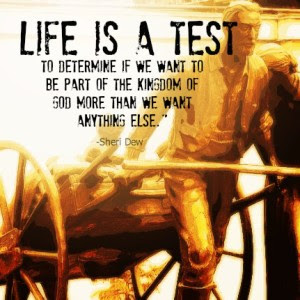CHRISTMAS MEMORIES
Lavona Richardson
These last few days in 2014 I have enjoyed reflecting back on so many memorable Christmas season’s throughout my life.
One of my first memories is the year when I was I received a beautiful porcelain doll that I still treasure. It was so beautiful with its pretty white dress with a pink coat and bonnet. I remember how careful I was to handle it so it wouldn’t break. Leona, my twin sister and I got baby dolls alike. Nena’s doll was a toddler doll that stood up. I still have that doll and treasure it.
Growing up my Mother and Daddy would not wrap the gifts but wait to put them out until Christmas Eve. Christmas morning we would have races into see the tree and then we would each have a turn to say what we saw before my mother played the piano as we all marched into the tree. The races were competitive with each one wanting to have the shortest time. Jay and I kept this tradition in our home as our children were growing up and now many of our children have Christmas races keeping up the tradition. As a child I didn’t have a Christmas stocking that I hung up so this tradition was brought into our family by Jay.
Another Christmas memory is coming home for Christmas from BYU after finishing finals and finding time to bring home gifts for everyone. It was about a twelve hour drive from Provo to Snowflake and we usually started out tired after our last final because we were so anxious to get home.
I left for my mission in Mexico in October 1955 checking out of school and becoming a missionary all in one weekend. My friends in my home ward didn’t know that we were on a mission until we didn’t come home for Christmas. Nena, Leona and I were all on our missions at the same time so none of us were home for Christmas. I was in Mexico for two years so missed being home for Christmas two different years. I remember helping our investigators and new converts find the true meaning of Christmas. The first Christmas in Mexico I was in Tampico and enjoyed helping the Primary with their program. I played the piano for them to sing. After the program we broke a piñata. Christmas 1956 I spent in Monterrey where I was serving as secretary to President Bentley and helping Sister Bentley with the Relief Society. In my journal I wrote that on Christmas Eve I was in charge of a release program for a missionary and then went out to the Nuevo Republic Branch to help with the Primary program. After the program the children broke a piñata filled with goodies. Other entries in my journal state that I made Christmas boxes to take to some families in need. I cooked the Christmas dinner for all the missionaries in Monterrey since Sister Bentley was busy with her family. I got home from my mission the end of October 1957 so spent Christmas with my family in Snowflake before going back up to BYU to finish my last classes to graduate in Elementary Education.
I graduated from BYU the summer of 1958 and started teaching 2nd grade at the Edison School. I remember helping my 2nde graders learn a song about each letter of the word “Christmas” for our school program. The song started out “C” is for the Christ Child born on Christmas Day. I had a wonderful class of 2nd graders and loved teaching. I gave my parents a special gift that year. I found a painting called “Slowpoke” of a little horse following a rider on a horse that my Daddy loved and cherished.
One of the most memorable Christmases was in 1959. Jay and I were married on December 22ndjust three days before Christmas in the Arizona Temple. Cecil and Sylvia were married the same day. We had a double wedding reception in Virden that night. We spent Christmas Eve with Jay’s family and all his little nephews and nieces. Christmas Day we rode up to Snowflake to spend the rest of Christmas with my family. We had a reception in Snowflake a few days after Christmas and drove back to Chicago to begin our own little family.
Christmas 1960 we had as 3 month old baby to help us celebrate Christmas. We rode the train to Arizona for Christmas. This was our first opportunity to show off our sweet little Miriam to our family. She was a doll. Everyone loved her. I will always remember how proud Jay was of his little daughter and how anxious he was to show her off and let his family and friends see how cute she was.
We spent the next two Christmases in Chicago since I t was too far and too expensive to come home. Jay graduated from Northwestern Dental School in May 1963 and our family had grown to three little girls. We packed up all our belongings and drove to Arizona and then back across country to Lewisburg, Pennsylvania where Jay spent a year working as a dentist in the Federal Penitentiary. Lewisburg is situated on the banks of the Susquehanna River. I remember that when we first drove into Lewisburg they were celebrating a historical event so all of the stores had antiques in them. I worried about how we were going to find toys for our little girls but soon learned that they had fun Christmas toys to buy there too. We were only in Pennsylvania for one Christmas. We were busy with Jay being the branch president in the Sunbury Branch which was very spread out and I was serving as the Primary President. Jay wanted to visit all the members at Christmas time so we did lots of traveling with our little girls. We made some good friends in Millersburg, Sunbury, and surrounding areas that we kept in touch with for many years. We went to Harrisburg about an hour away for our district meetings.
Christmas 1964 was spent in Arizona with a new baby. We lived in a rental home on 11th street in Tempe and Jay worked as a dentist on North Central Avenue in South Phoenix. Joann was born in November. We bought dolls and doll buggies for our four little girls and loved providing Christmas for them.
We moved into our new home at 304 East Geneva in Tempe before Christmas 1965. With our little girls we started lots of Christmas traditions. I made cinnamon rolls for Christmas morning; we hung Christmas stockings and introduced the girls to the races into the tree. I sewed dresses alike for the four girls. They loved to perform and learned some cute songs that entertained their grandparents and friends.
Vernon was born in July 1966 so for Christmas that year we added trucks and trains to our dolls and doll dishes and continued our Christmas traditions. Another tradition we began was a Nativity pageant on Christmas Eve with the children acting out the Nativity as Mary, Joseph, the baby, shepherds, wise men, etc. We kept that tradition up each year and it is still something that we do in our family. The children still performed a lot and added their little brother to their productions.
A fun Christmas memory during this time of our lives is the Christmas that we put a key under the Christmas tree. The children had to figure out what the key opened and were so delighted to find a cute little doll house out in our back yard big enough for them to play inside. The house had a window flower box, cupboards and cute little furniture. The girls spent many hours enjoying their dolls and playing in their doll house.
We started sending out Christmas cards each year with a Christmas poem Jay wrote. Often he would write another poem to include giving an update on our family. The next years our Christmases were busy. As the children grew older we were involved with school programs, primary programs, and other activities. We enjoyed a new family tradition of caroling to our friends. We taught our children to play Christmas carols on the chimes to add to our Christmas caroling. Ray went caroling with us after his birth in 1969 and Kenneth in 1970. We added more gifts to our Christmas tree and our children loved their Christmas stockings and Christmas races.
Another Christmas memory is the year that I had the Christmas cinnamon rolls all made and sitting out on the sideboard in the utility room at “304”. Jay brought in an old bicycle to paint for the girls to make it look like new. I hadn’t covered the cinnamon rolls so they got paint on them and had to be thrown out. I had to make another batch of cinnamon rolls.
Changes came to our family when in January 1972 just after Christmas Donald was born and only lived for seven hours. More changes came because we moved that year to a bigger home just a few blocks away on Broadmor. Christmas 1973 was made special because we Dale entered our family. He had eating problems and never was very healthy. He made a wonderful baby Jesus at our Christmas pageant that year before he died in January 1973. These were difficult years losing two babies in just a couple of years.
The year 1974 brought joy and more changes into our family with our “almost twins” Margie and Melvin. Two babies brought lots of joy to our family. I took lots of pictures of our twins and the double fun they gave our family and our Christmas activities.
Our older girls were very musical. We went to lots of fun Christmas programs where they sang and played musical instruments. Miriam learned to play Handel’s Messiah and accompanied her high school choir singing it. Marlene was one of the top sopranos and they all loved music and performed in choir, orchestra, band and ward and stake programs.
Dean joined our family for Christmas 1976 and brought lots of joy. He was a cute little boy who loved hats and make believe. Amy was born in November 1978 making our family complete. She was a cute baby for our Christmas pageant in 1978. Each one of our children added to our Christmas joy and the fun we all had of finding the right gift for everyone.
More changes came to our family when Miriam graduated from Tempe High and began school at BYU. Marlene joined her in 1979. I have special memories of Christmas that year. When Miriam and Marlene arrived home from Utah after finishing their finals they insisted that we open their Christmas gifts early. They had painted a beautiful seventeen piece Nativity set for us complete with Mary, Joseph, the baby, 4 shepherds, 2 sheep, a cow and a donkey, three wise men with three camels some of which are almost a foot tall. This was the start to my collection of Nativities from all over the world. We bought an olive wood Nativity when we were in Israel with Miriam when she was there with the Travel Study from BYU. Our missionary sons brought us Nativities from places where they served their mission. Melvin had some special Russian eggs painted to display the Nativity and many others. I enjoy each year arranging about 100 different Nativity sets from around the world.
More changes came into our family and we didn’t always have all of our children around us. We enjoyed them when they were able to be with us and communicated with them when they spent Christmas somewhere else. The first to leave was Marlene when she married Mark in 1981, followed by Tony that married Miriam in 1982, Fred married Rauna in 1983 and Robert married Joann in 1985. They started their own family traditions but came home to enjoy Christmas with us. As the grandchildren started coming we enjoyed having little ones around and the joy that children bring. Vernon left for Venezuela for his mission in 1985 followed by Ray assigned to Japan, 1988 and Kenneth served his mission in Scotland in 1989. More changes came as Melvin was called to Russia and Margie served in Chile on their missions. We continued to have more temple weddings in our family with Vernon marrying Connie. Kenneth and Jenni married in the Arizona Temple in 1993 just a couple of days after Christmas. Several years later Melvin married Tami and Margie married Russ. Just a couple of years ago we went to Washington to be with Dean and Jennifer as they celebrated their Christmas wedding.
The years passed with lots of fun Christmases made special with new babies and new traditions along with keeping the old traditions. Jay retired from Dentistry and we were called to serve a mission in Indonesia. This brought more joy to our Christmas celebrations. We were in Indonesia away from our family for Christmas 2003 and 2004. The first Christmas the only gift we got for Christmas was an orchid plant given by one of our friends. Melvin and Tami visited us about a month later and brought gifts from home. Our last Christmas in Indonesia we chose to stay a few weeks longer on our mission so that we could help our new converts enjoy their first ever Christmas celebration. A special memory of a miracle is when we went out to Jasinga with the package of Christmas gifts Miriam sent to us. She had in the package Christmas lights. We told our friends we needed a tree so we watched as they cut down a tree and brought it into the house. We strung the American lights around the tree but then realized they didn’t have electricity. Our Indonesian friends hooked up a generator. The electricity in Indonesia is different so the American lights were not supposed to light but we had a Christmas miracle and they did light. A memory that I will never forget is seeing the children’s faces as they saw a Christmas tree and Christmas lights for the very first time. I am grateful that Miriam had provided gifts that we had wrapped to give to all of the children.
We were not home for Christmas in 2005 or 2006 because after getting home from our mission in Indonesia we were anxious to serve a senior mission again and this time were assigned to be missionaries in Nauvoo. The Christmases in Nauvoo were very different than the ones in Indonesia because we were around lots of other missionaries and participating in a Christmas walk around the Nauvoo sites and other missionary activities.
I have only highlight ted a few Christmas memories. There are so many more. Some Christmas activities stay the same and others change. I am happy to learn that many of my children still have Christmas stockings, Christmas races and Christmas pageant on Christmas Eve when the children re-enact the story of the first Christmas. Many still have homemade cinnamon rolls on Christmas morning and all have the joy of being around Christmas with family. This is my fourth Christmas to not have Jay with me. Jay loved Christmas. He loved buying the oranges, apple and little gifts to fill the stockings. He loved helping me decide what to give to each of our children and grandchildren. I love Christmas too. I love the Christmas music, Christmas lights at the temple, homes and businesses, Christmas stories and the lights on the Christmas tree. I love reading Christmas poems especially the ones that Jay wrote and left for us. I love planning what to give each of my children and their families for Christmas. All year I work at getting ideas of what to give that will bring joy into their lives and express to them the love I have for them. I look forward to decorating my home for Christmas, setting out all of my Christmas Nativity sets and other decorations. Each one has a special memory. I love having all of my family come to my home for my family Christmas program and the opportunity to be together. I love telling my Christmas story and Ray or grandchildren singing Jay’s song, “Mary Sweet Mary”. I love going to the various homes on Christmas and enjoying the Christmas spirit there. I love Christmas and look forward to more made special by my 11 children and their spouses, 65 grandchildren and 25 great grandchildren with more on the way. Each one is very special to me and each one makes Christmas something that I look forward to. I am grateful for my Savior, my Redeemer whose birth and life we celebrate at Christmas time. I want my children to know that I have a testimony that Christ’s church is again upon the earth restored in these Latter-days. I know that we have a living prophet that receives revelation for His church. I know that because of Christ’s resurrection and atonement I can be with Jay again if I live worthy and we can be an eternal family. I am grateful for my family and that they all celebrate Christmas like I do and are living good lives.










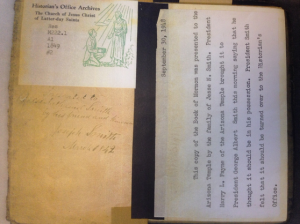

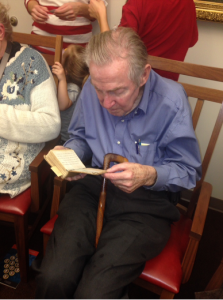








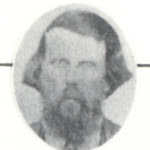
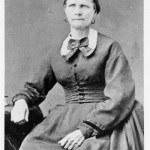 The exodus toward the west began in 1846, but Father remained behind until the Spring of 1850 assisting other families to leave. The company in which we crossed the plains was not very large. We made good time on the trip. I walked most of the way from the Missouri River to the Great Salt Lake Valley. We all walked who were able to lighten the load of the poor oxen. I was always glad when it came time to camp. The oxen soon learned without much gee-ing and haw-ing how to place the wagons to form a circle, leaving very little space between the front wheel of one and the near hind wheel of the wagon ahead.
The exodus toward the west began in 1846, but Father remained behind until the Spring of 1850 assisting other families to leave. The company in which we crossed the plains was not very large. We made good time on the trip. I walked most of the way from the Missouri River to the Great Salt Lake Valley. We all walked who were able to lighten the load of the poor oxen. I was always glad when it came time to camp. The oxen soon learned without much gee-ing and haw-ing how to place the wagons to form a circle, leaving very little space between the front wheel of one and the near hind wheel of the wagon ahead.